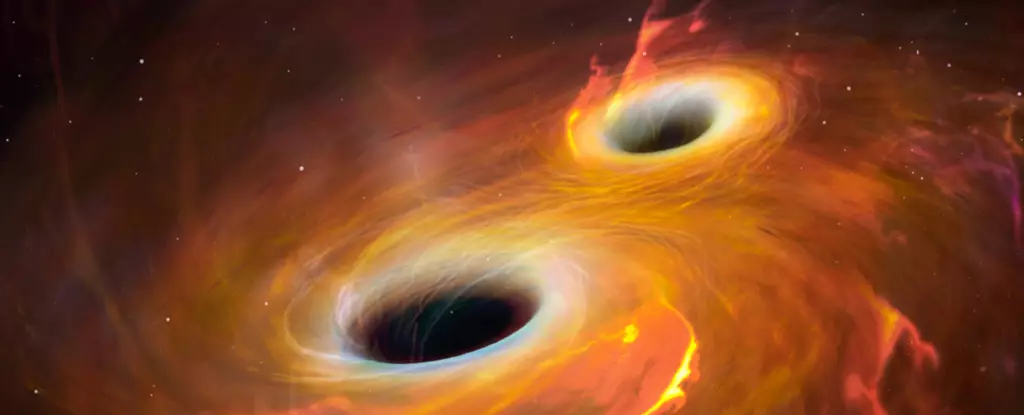At the very heart of our Milky Way galaxy lies a supermassive black hole known as Sagittarius A* (Sgr A*), a focal point of cosmic wonder and extraordinary phenomena. Encircled by a cornucopia of celestial bodies—young stars, interstellar gas, and dust—this region stands as a bustling hub of astrological activity. The true essence of this galactic center, however, remains enshrouded in a thick veil of gas and dust, hiding it from our eyes and limiting our ability to observe its intricate workings in visible light. Instead, researchers have turned to infrared and radio wavelengths, providing a unique glimpse into this enigmatic environment. Yet, a lingering mystery persists: the stellar-mass black holes nestled within this bustling galactic metropolis.
The Challenge of Detection
Detecting black holes, particularly those of stellar mass, poses significant challenges for astrophysicists. Traditional models propose a range of estimates, implying there may be as few as 300 black holes in the immediate vicinity of Sgr A*. These models surmise that Sgr A* might have kickstarted the formation of relatively fewer stellar-mass black holes through the death of massive stars. However, a groundbreaking study recently published in Astronomy & Astrophysics suggests a seismic shift in our understanding; the actual number of these elusive black holes could be substantially higher. The implications of this new model could revolutionize our perspective on the dynamics at play in our galaxy’s heart.
The Star Grinder Phenomenon
What makes this new hypothesis truly revolutionary is the mechanism behind it, aptly named the “star grinder.” The model posits that the dense concentration of gas and dust in Sgr A*’s proximity facilitates rapid formation of large O-type and B-type stars. Given their ephemeral nature—typically living only a few million years—these stars end their lifecycles in catastrophic supernova events, subsequently collapsing into black holes. The remnants of these stellar explosions contribute material for new star formation, creating an extraordinary cycle: stars are born, die, and in doing so, nurture the creation of more black holes.
Over time, the processes catalyzed by this ‘star grinder’ would lead to a significant aggregation of black holes in this galactic core. Such hyper-concentration implies a chaotic celestial ballet where the risk of collisions between stars and black holes would become exceedingly common. It’s an exhilarating idea that positions our galaxy’s center not just as a passive location but as an aggressive crucible driving star and black hole formation.
Collision Time: A Statistical Approach
In order to validate their model, the researchers draw on a statistical concept called “collision time.” This metric is critical: it determines the average time before a star collides with a black hole, an event influenced by both the density of black holes present and the size of the star involved. A higher density of black holes would naturally correlate with a reduced collision time, while larger stars increase the likelihood of such catastrophic encounters, yielding striking conclusions.
By calculating collision times for various spatial distributions of black holes, these scientists benchmarked their findings against observable data. The analysis paints a vivid picture: The diminished population of colossal O-type stars in our galaxy’s core as opposed to other regions suggests they have fallen victim to the ravenous grip of black holes. In contrast, the prevalence of smaller B-type stars indicates a lesser threat from black hole interactions. This statistical dance culminates in an astonishing estimate—around 100 million stellar-mass black holes could inhabit every cubic parsec surrounding Sgr A*.
The Enigma of Hypervelocity Stars
One of the most captivating implications of this new understanding pertains to the existence of hypervelocity stars seen darting through the galaxy at incredible speeds. Approximately a dozen of these stars travel with velocities great enough to escape the gravitational grip of the Milky Way. How can a star acquire such formidable momentum? The “star grinder” model provides a compelling explanation: close encounters with black holes can catalyze acceleration, propelling stars into the cosmic void and thus contributing to our galaxy’s dynamic narrative.
This deep scrutiny into the nature of black holes at the heart of our galaxy reveals not just a passive observation, but a vivid tableau of cosmic interactions shaping our universe. As scholars continue to disentangle the drama surrounding Sgr A*, we find ourselves peering into the very mechanisms that govern celestial life and death, gaining insights that transcend simple observation and touch upon the profound rhythms of our cosmos.
Ever-evolving, the cosmos remains a theater of mystery, and we are but humble spectators seeking to decipher its grand performance.

